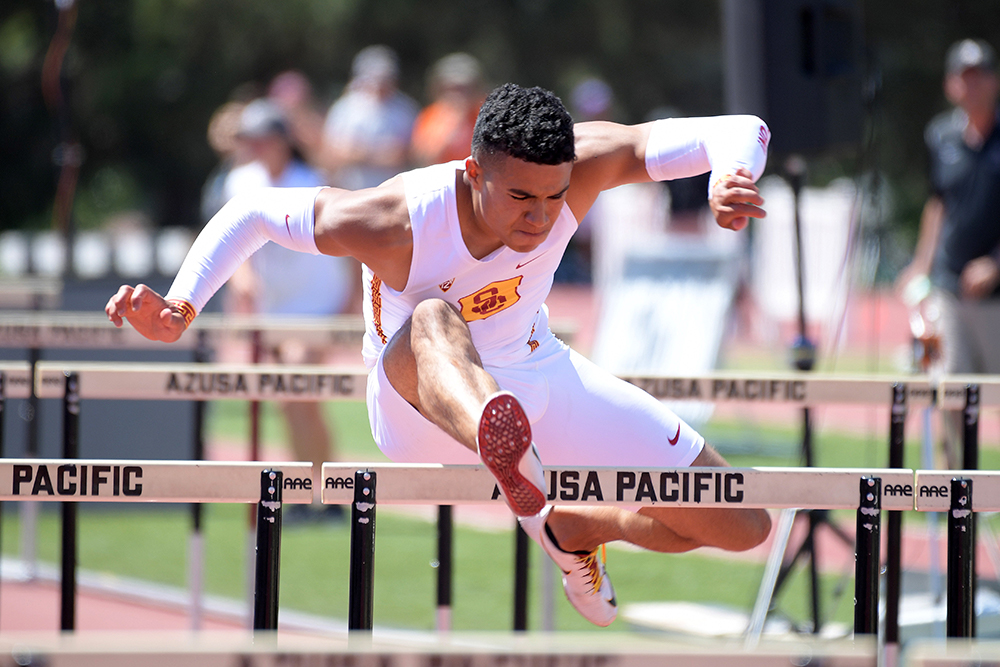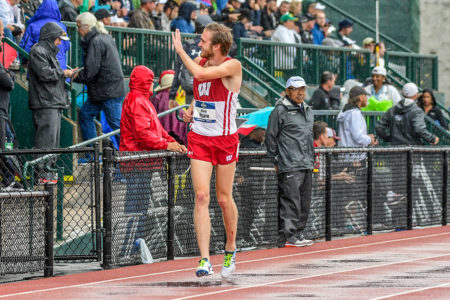
AYDEN OWENS, contesting his first decathlon with the big international implements, turned back NCAA formchart favorite Harrison Williams of Stanford by 18 points with an astounding total of 8130 at the Bryan Clay Invitational. That score by the 18-year-old USC frosh is the No. 3 all-time tally by a Junior and has only been bettered even with lighter/shorter Junior implements by an additional 5 U20 performers.
A Pennsylvania high schooler who set his Junior-implement PR at 7354 last year, Owens broke out fast in the 100, clocking 10.43, an 0.21 PR that saw him cross 0.35 ahead of 2nd in a field that included ’18 NCAA champ Tim Duckworth. PRing in all his first-day events but the high jump, Owens added marks of 24-8½ (7.53), 44-0 (13.41), 6-2¾ (1.90) & 47.66 to finish the first half with 4266 points, 72 ahead of Williams. An 8000-point finish looked possible to achieve but a reach goal as Owens, not a notably strong thrower as a prep, would be spinning the Senior discus in a multi for the first time.
“It was just a matter of staying in it mentally,” says Owens. “A big part of the decathlon is staying focused and not letting your body boss you around. Let your mind rule your body and I listened to my coaches and stayed mentally strong.”
Says Trojan multis/jumps coach Carjay Lyles, “The hidden gem that we knew we had in our back pockets is that he’s not a weak thrower. He is very, very good on the long throws. Coach Dan Lange works with him on the throws as well and has really instilled some of the foundational principles—even for his first competition, to be able to throw as far as he did. That was a secret we knew he had in reserve; we knew we just had to stay close enough, or far enough ahead, to make sure we were still on pace to do some things.”
Owens—T&FN’s No. 2 prep All-America in the 110H last year—bounded over the high barriers in 13.91w (2.2) to begin day 2 and increase his lead to 123 over Williams. Then out came the “hidden gem” of the DT. Despite two fouls, Owens spun his second throw out to 141-6 (43.14), 21 inches longer than Williams’ best.
In the vault, Owens negotiated 15-1 (4.60) before passing on his final attempt at 15-5. Cardinal senior Williams, a noted vaulter, as expected rode that event with a 16-8¾ (5.10) clearance to a 17-point lead. For Owens at 6771 points, the 8000-point barrier now looked surmountable. The Trojan yearling PRed on each of his three javelin throws to finish at 168-0 (51.21), 5-11 farther than Williams and back in the lead by 10 points.
“I wasn’t telling him throughout the competition what he was doing or where he was at on his point total,” Lyles says. “I was trying to make sure he didn’t hear the announcer say it so he didn’t get caught up in that.” But with the win and now 8100-point possibilities on the line, Lyles made sure Owens understood the stakes for the final event. “To be a guy who is very speed/power-based and be able to go out there and run a time that cut almost 15 seconds off your PR in the 1500,” Lyles says, “to do that to get the win in the competition and to score over 8100 points, we knew he had to run 4:30. So to be able to do it at the end of your first decathlon as a collegiate athlete, you couldn’t ask for more than that as a coach.”
Owens represented Puerto Rico at the World Juniors last summer, and it was in that meet he set his previous metric mile best, 4:44.76. Here he timed 4:28.90, 1.26 in front of Williams and 18 points ahead for the win. The Cardinal multi man’s 8112 was a PR also, by 80 points.
Says Owens, “Before the 1500m, my whole life flashed before me and I said I was just going to get this guy. I knew it was going to hurt, but it’s only 4:30 of pain and I said I was just going to take it.”
The “two events that really shocked us,” says Lyles, were the long jump and the 1500. “Indoors we were really struggling with the long jump. So to finally have a breakthrough performance and get some consistency in the long jump [was a welcome surprise].” What brought out the stunning score, says the coach, “was just really the balance of keeping that energy level at a playful and intense level but not too intense to where he became tight. He was competing in a group with a couple of former NCAA champions so to be in that collective and recognizing, ‘Hey, just stay calm and relaxed and steady, and allow your performances to come.’ So with that mindset, it really just opened up the doorway to be really relaxed when he stepped in a ring or behind the blocks. He just took off. Over and over, and he just rode that wave.”
With 7 more weeks to work through before the NCAA is held at Texas, Lyles adds, “I think our biggest plan is just preparing for Austin, just looking at the big picture, and every meet lined up, even the conference meet, is just for making sure he gets to Austin at his best—utilizing the upcoming dual meet and the Pac-12 meet and the Regional meet to get in some events and some races. When we get to Austin we just want to be better than we were here. If we can just be better than at the meet prior, we’ll stay in a good position and stay PRing.”






